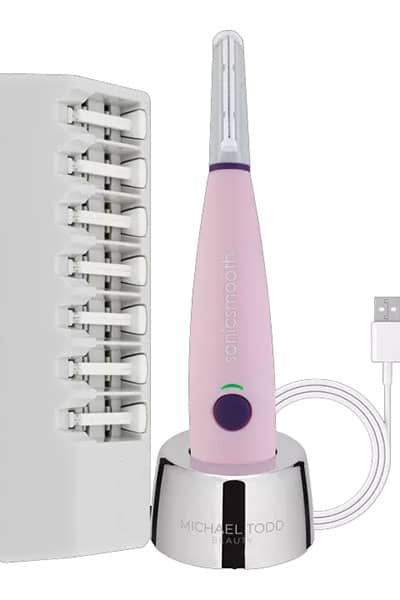We may earn money or products from the companies mentioned in this post at no additional cost to you.
TABLE OF CONTENTS
How Often Should You Schedule a Dermaplane Treatment?
Dermaplaning is an exfoliating treatment that has become increasingly popular in the skincare industry. It involves using a very sharp blade to gently scrape off dead skin cells and facial hair, giving your skin a smooth and glowing appearance. While dermaplaning has numerous benefits, it’s important to understand how often you should be dermaplaning for optimal results. In this article, we’ll explore what dermaplaning is, its benefits, preparing for it, aftercare instructions, frequency of treatments, and any risks associated with it. We’ll also review professional versus home dermaplaning so you can make an informed decision about which option is right for you.
What is Dermaplaning?
Uncover your skin’s true potential with dermaplaning – a revolutionary exfoliation technique that will leave you feeling renewed and glowing! Dermaplaning is a form of physical exfoliation that involves using a specialized blade to remove dead skin cells and vellus hair (also known as peach fuzz). It’s important to remember that the frequency of treatments depends on the individual. Generally, it’s recommended to get dermaplaning every 4-6 weeks in order to achieve optimal results. However, if you have sensitive skin or are prone to breakouts, you may want to opt for less frequent treatments. How often should you do dermaplaning? An experienced esthetician can help determine what schedule works best for your skin type and goals.
To reap all the benefits of dermaplaning, it’s essential to find an experienced provider who can safely perform the procedure. With proper care and maintenance, dermaplaning can reveal brighter, smoother skin while minimizing signs of aging – helping you look and feel your best! Moving forward, let’s explore the many benefits this gentle treatment has to offer.
Benefits of Dermaplaning
By dermaplaning, you can reveal a smoother, brighter complexion that’s sure to make heads turn! Dermaplaning is a form of exfoliation that uses a special tool with a medical-grade blade to remove dead skin cells and vellus hair. It leaves the skin feeling smooth and even, while also increasing cell turnover and stimulating collagen production. Regular dermaplaning can help reduce the appearance of fine lines and wrinkles, give your skincare products better absorption, as well as minimize the appearance of acne scars. When it comes to how often should you dermaplane, it’s generally recommended that you do it every 4-6 weeks for maximum results. However, if you have sensitive or easily irritated skin, you may want to wait until 8 weeks between sessions. The best way to determine how often you should dermaplane is by talking with an esthetician or dermatologist who knows your skin type and condition best.
Preparing for Dermaplaning
Start by scheduling an appointment with a licensed esthetician or dermatologist. Make sure to let them know if you have any health conditions that may affect your dermaplaning results. Before your appointment, it’s best to avoid sun exposure and skin irritants such as retinol, alpha-hydroxy acids, acne treatments, and tanning beds. You should also remove all makeup and cleanse your face before going in for treatment. To ensure maximum comfort during the procedure it is recommended that you trim facial hair prior to arriving at your appointment. Afterward, you should be ready to enjoy the smooth and radiant skin that comes from this safe and effective exfoliation technique.
These simple preparations will help make sure you get the most out of your dermaplaning experience. With proper aftercare maintenance following treatment, you can maintain healthy skin between sessions for long-lasting results.
Aftercare for Dermaplaning
Discover the benefits of dermaplaning with proper aftercare to maintain soft, glowing skin between sessions! Immediately after a session, your skin will feel smoother and softer. To get the most out of dermaplaning, you’ll want to take care of your skin following a treatment. Aftercare includes avoiding direct sun exposure for at least 24 hours and applying sunscreen every day with an SPF 30 or higher. Additionally, moisturizing regularly is important to keep your skin hydrated and protected from environmental damage. You may experience some redness in the days immediately following dermaplaning, but this should subside quickly if you follow the recommended aftercare routine. With consistent use of these steps, you can enjoy smooth and fresh-looking skin between appointments.
By practicing good skincare habits in concert with your regular dermaplaning treatments, you’ll be able to maximize its long-term anti-aging effects and maintain healthy looking skin all year round. In order to do so however, it’s important to understand how often you should be getting dermaplaned – which we explore further in the next section!
Frequency of Dermaplaning
Frequency of dermaplaning can vary depending on your skin type and overall goals, so it’s important to consult with a professional to determine the best plan for you. Most people will benefit from having a dermaplaning treatment every four to six weeks. However, if you have very sensitive or delicate skin, you may need to space out treatments even further. It is also important that any underlying dermatological conditions are cleared up before beginning treatments in order for them to be effective. Additionally, some individuals may only need occasional maintenance appointments in order to keep their skin looking smooth and healthy. No matter what your individual needs are, consulting with a professional is the best way to ensure that you get the most out of your dermaplaning sessions. With this information in mind, let’s move onto discussing the potential risks associated with dermaplaning.
Risks Associated with Dermaplaning
Dermaplaning is a safe and effective skin rejuvenation treatment, but it does come with some risks. It’s important to consider these potential risks before deciding whether or not dermaplaning is right for you.
The most common side effect of dermaplaning is minor irritation and redness that usually resolves within 24 hours after the procedure. Other rarer risks include infection, scarring, hyperpigmentation, and allergic reactions to products used during the procedure. Therefore, it is always best to seek professional advice from a qualified aesthetician or dermatologist prior to undergoing any kind of dermaplaning treatment. With careful consideration of these risks in mind, let’s now take a closer look at the differences between professional and home dermaplaners.
Professional vs Home Dermaplaning
If you’re considering dermaplaning, knowing the difference between professional and at-home treatments is important. Professional dermaplaning is performed by a certified esthetician or dermatologist using sterile tools. This method requires training in proper technique and safety measures to ensure that skin is not damaged during the procedure. The professional can also advise on how often to come back for treatment. At-home treatments involve using a specialized razor blade or blade attachment with a handheld device that may be found at beauty stores or online. However, it’s best to exercise caution when performing this type of treatment as there are potential risks, such as cutting too deep into the skin or bacterial infection from using dull blades. It is also important to research which products are safe and recommended for use with at-home dermaplaning devices. Ultimately, seeking advice from a professional can help guide you toward making the best decision for your skin’s needs when determining your own frequency of dermaplaning sessions.
How Often Should You Dermaplane: Conclusion
The frequency of dermaplaning treatments will depend on the individual’s skin type and goals. Generally, dermaplaning is performed every four to six weeks to maintain smooth, glowing skin. This allows your skin to heal and fully benefit from the effects of the treatment. If you are unsure about how often to dermaplane, consult a professional for an individual recommendation that is tailored to your specific needs. Keep in mind that there are risks associated with this procedure, so it’s important to follow all necessary safety precautions and aftercare instructions given by your practitioner. By following these steps, you can maintain smooth and radiant skin for years to come!









